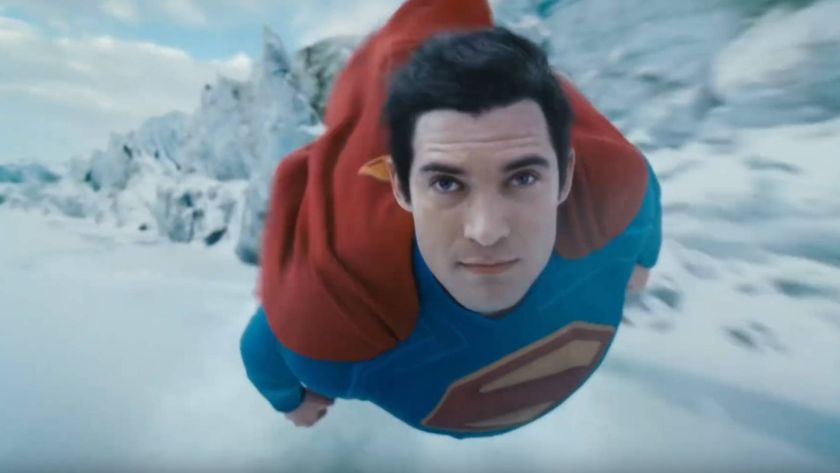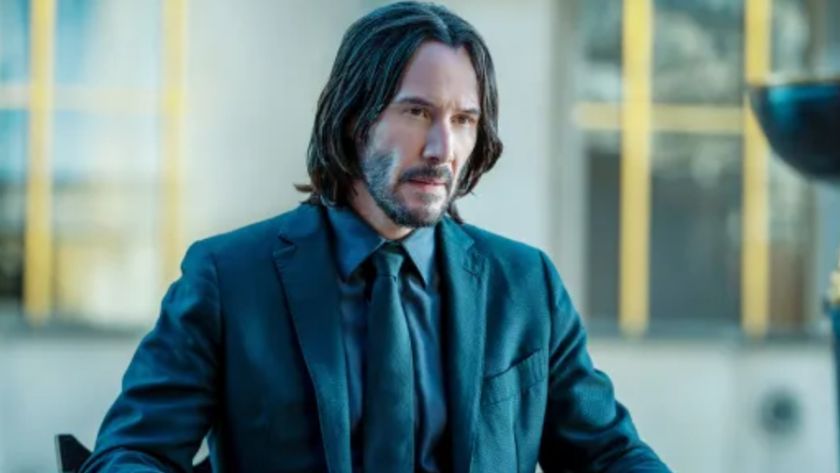The Story Behind Battle Los Angeles
A war movie with aliens...
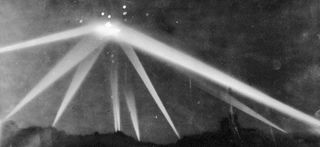
The Battle
On 25 February, 1942, spaceships were spotted flitting along the Los Angeles coastline. Mere months after the attack on Pearl Harbour in December 1941, not to mention the US’ entry into the Second World War, it certainly seemed that the apocalypse was nigh.
At 2am, reports of the UFO sightings began. Air raid sirens were sounded, and at just after 3am, the 37th Coast Artillery Brigade opened fire on the large, unidentified aircraft flying along the coastline.
Within just 58 minutes, more than 1,400 shells were unloaded as the Brigade followed the strange objects in the sky from Santa Monica to Long Beach. But their defence was futile.
Says UFO expert Bill Birnes: “Not one artillery shell could hit the craft – out of all the hundreds of shells that were fired. People outside that night swore that it was neither a plane nor a balloon – it was a UFO.
“It floated, it glided. And to this day, nobody can explain what that craft was, why our anti-aircraft guns couldn’t hit it – it’s a mystery that’s never been resolved.”
Later, the US Air Force would attribute the evening’s events to war nerves, and reasoned that the Brigade had simply been firing at a weather balloon. For ever more, though, that night would be referred to as The Battle Of Los Angeles...
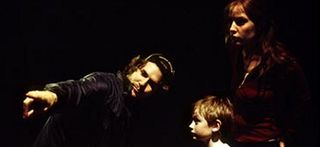
Liebesman Lives
Fast forward 60 years, and a young director called Jonathan Liebesman is taking tentative steps into the movie world. It’s 2002, and the Johannesburg native has just directed his first movie at the age of 26.
Darkness Falls was a horror flick that took the tooth fairy legend and twisted it into a dark, slasher-esque fairytale.
Though it opened at number one at the US box office, Liebesman’s film debut suffered savage reviews (“toothless,” condemned Las Vegas Weekly ). Still, it took a hearty $47m worldwide.
That box office success connected Liebesman with his next film in 2005. A 15 minute short entitled Rings , it was a film that linked The Ring remake with upcoming sequel The Ring Two .
Praised by fans, Rings earned Liebesman the attention of Hollywood heavyweight Michael Bay, who welcomed the young director into his Platinum Dunes production company.
The result of that union was The Texas Chain Saw Massacre: The Beginning . But despite that film’s box office success, Liebesman still wasn’t fully satisfied with the films that he was making. It wasn’t until after creating 2008 political thriller The Killing Room that he turned his attention to sci-fi...
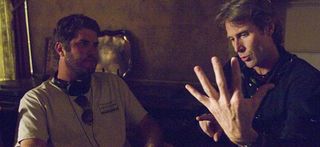
Fictional Science
In November 2008, Columbia Pictures officially announced that Jonathan Liebesman had been hired to direct a tentpole sci-fi film called Battle: Los Angeles .
Based on a story by Chris Bertolini, itself inspired by the real-life Battle Of Los Angeles, it would follow a Marine platoon’s fight against invading aliens. Dark Knight star Aaron Eckhart was already attached to head up the cast.
For Liebesman, who has since all but disowned Darkness Falls , Battle: Los Angeles was right up his street.
“These genres, war movies and aliens, are much more of a passion than horror movies were for me,” he reveals. “That was sort of a way to break in, for someone who doesn’t write his own material.
“And this kind of stuff is much more what I’m interested in and where I would hope to keep going and improving. You know, getting better scripts in these types of genres is kind of what I’m hoping to do.” This was a man with ambition...
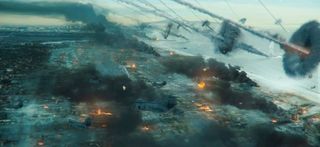
Aliens vs Marines
“I met Jonathan before he was hired,” recalls Eckhart, who plays a no-bullshit rifle platoon sergeant in the film, “and he said he wanted to make the most kick-ass fucking door-to-door documentary-war-alien movie ever. And that’s what we’re doing.”
For Liebesman, Battle: Los Angeles wasn’t just a chance to make another movie about invading ETs; it was a chance to make the movie he’d always wanted to make. It, also, wouldn’t just be any old sci-fi in the traditional sense.
“I mean, on IMDb I’m sure it’ll have [ the movie listed as ] ‘action/sci-fi’,” the director says. “My goal was: ‘I want to make a war movie with aliens.’ Not an alien movie that happens to have soldiers. There’s an ‘incidental-ness’ to the aliens.
“At the same time, what that allows me to do is not get into political reasons for, ‘Why are we fighting this war? Is this a good war, or is this a bad war?’
"I just want to watch guys who put their lives on the line, how they bond, what they do for us. That kind of stuff. That’s what I was interested in.” It was time to shake up sci-fi...
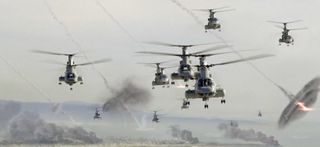
No Landmarks
Go-to alien invasion film Independence Day may have blown up the White House, but Liebesman never attended The Roland Emmerich School Of End-Of-World Disasters.
His film would go against the big budget destruction of well-known landmarks, instead aiming for realism over everything else.
“With this movie I didn’t want it to be about taking out the landmarks,” says Liebesman. “To an alien, or to someone who’s not from America, I think that you don’t know what’s supposed to be a landmark.
“To me, Los Angeles is freeways and buildings and a beach… that’s kind of what it meant to me. I didn’t want the Capitol Records [ Building ] or the Hollywood Sign.
“Obviously you’ve seen that kind of stuff before, done in $200 million movies. There’s no point in trying to outdo that. So [ I ] just [ decided to ] do it on a much more sort of ground, visceral level.” His leading man agreed...
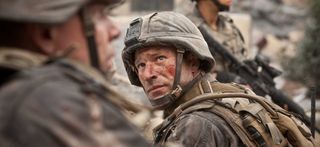
Eckhart
“It’s the same thing with The Dark Knight ,” Eckhart reasons, “you know Chris [ Nolan ] uses green screen, but the movie doesn’t rely on green screen.
"So you always get that feeling from Chris that this movie is real, and that’s why it adds that depth and texture. I think that it’s the same thing with this film.”
With Battle: Los Angeles , Eckhart’s vision completely chimed with Liebesman’s. Together, they wanted to craft a no frills war movie that had an injection of sci-fi. Black Hawk Down meets Alien .
Eckhart, though, was as drawn to his character as he was to the unique angle of the project. “I liked his discipline,” the actor says of Marine Staff Sergeant Michael Nantz.
“I liked that he can take care of himself in any situation. He’s a survivalist, he teaches through tough love. Loves his men, but doesn’t coddle them. He’s not a new age marine.”
For co-star Lucas Till – who’s had small roles in The Spy Next Door and Hanna Montana: The Movie , but will star as Havoc in this year’s X-Men: First Class – Eckhart’s description of Nantz might as well apply to the actor himself.
“Aaron is a workaholic!” Till enthuses. “He just basically goes in. He broke his arm and I would never have known. He still went to work the same as if nothing had happened, which I respect a lot. That is work ethic!” But a platoon leader needs a platoon...
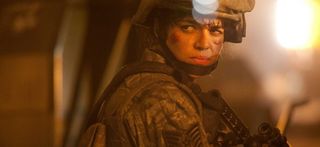
Two Rods
“It's basically any 19-year-old guy's dream job,” says Till, who plays Corporal Scott Grayston. “I get to go to work and shoot guns all day so it's pretty awesome."
Till may be new to the action game, but one person who knows her high-kicks from her karate chops is Michelle Rodriguez.
The 32-year-old actress has suited up for everything from S.W.A.T and Avatar to Resident Evil , meaning she was perfect to play USAF Technical Sergeant Elena Santos.
"Basically I was thrown into the mix through my buddy Neal [ Moritz, producer ],” says Rodriguez, “and he just thought it would be kinda cool to have another chick cause it was all dudes and just one female, so he said let’s balance it out a little bit.
“So two weeks before shooting I was thrown into the mix. I met with Jonathan and he was just really creative and open, which is the two main things that I look for, and smart. So immediately I was like, ‘Alright, let’s do this.’ I’m always in for like an impromptu adventure.”
Michelle joined another Rodriguez in the form of Ramón Rodríguez, whose biggest jobs thus far include TV smash The Wire and Transformers: Revenge Of The Fallen . He signed on to Battle: Los Angeles as Marine 2nd Lieutenant William Martinez.
“I met with Neal as well,” says Ramón. “I thought it looked really cool. So when I read the script I was like, first thing how are these aliens gonna look? If they don’t look cool, I don’t think the movie’s going to be good at all.” He needn’t have worried...
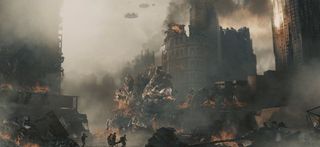
Unseen Enemy
Taking his cue from the very best filmmakers, Liebesman realised early on that in order to give his alien entities real menace, he’d have to keep them off-screen as much as possible.
“I wanted the movie to feel like you see the enemy like how the real military sees their enemies in an urban combat,” he explains.
“You don’t see them right away. Enemies have tactics, they hide, they don’t want to reveal themselves, they have self-preservation, and they hide behind cars and trees.
“That was the concept. You naturally see them like when you’re in a war. When you see them, you see them. Imagine you went to Iraq or any territory where you’re facing something. They would be hiding.
Elaborating on Battle: Los Angeles ’ own breed of alien, Liebesman clears up any question regarding their motivation, taking his war metaphor to its obvious conclusion:
“They invade and wipe us out like genocidal Nazis. I think it’s pretty black and white. They look at us like we look at ants. You just wanna get rid of them, but they wanna get rid of us.” Now they just needed to design them...
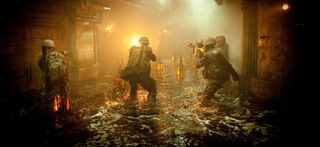
ET Designs
London designer Paul Gerrad was the man that Liebesman plumbed for to create the look of his extra-terrestrials. Crafting an appearance that was neither arthropod nor vertebrate, Gerrad designed aliens like nothing Liebesman had ever seen before.
“Paul Gerrad created something that was very alien,” the director says. “Not Alien the movie, but alien in as something weird. It wasn’t a creature and it wasn’t an insect. It was just something I couldn’t explain.
“I loved that. It’s something you can identify with easily. We have an alien I believe in. It’s an army. There’s lieutenants, colonels, medics, and stuff like that. It was important for me to believe that they were an army.”
One thing we do know about these aliens is that they want Earth because of its natural resources – namely our water (sort of like The Faculty ). They’ll also be rendered almost completely in CGI.
“What I wanted to do with them would be too difficult to do practically,” Liebesman explains. “However, we had reference guys play aliens for the eye-lines for the actors.
“We had a special technical advisor just for the alien combat sequences. The guys who were the aliens had techniques and tactics so the animators could have something to reference.” There was a problem on the horizon, though...
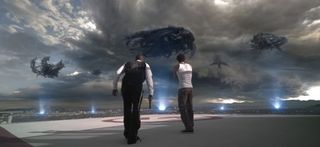
Skyline
Originally, Greg and Colin Strause’s special effects company Hydralux was hired to craft the CGI effects for Battle: Los Angeles .
But after taking the Battle: LA gig, the brothers – who previously directed Aliens vs Predator: Requiem – debunked to make their own alien invasion film Skyline .
Sony were furious, and began investigating the possibility of legal action against the directors. They claimed that the Brothers should have told them that they were planning their own alien film, which could compromise their work on Battle: LA .
In response, the Strause Brothers issued this statement: “Any claims of impropriety are completely baseless. This is a blatant attempt by Sony to force these independent filmmakers to move a release date that has long been set by Universal and Relativity and is outside the filmmakers’ control.”
In the end, no legal action was taken – perhaps because of Skyline ’s failure to become either a critical or box office success. Back on Battle: LA , it was time for the actors to get some training...
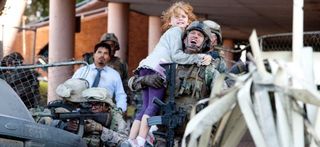
In Training
Michelle Rodriguez’s previous experience playing cops and armed forces characters meant that she already had a head start in the training stakes – a good thing considering how late she came on.
But Battle: LA provided a unique challenge in that she would this time be training with Marines. “The Marines I’ve never trained with,” she says. “I’ve trained with Navy Seals before, but never the Marines. It’s kind of cool.
“I can take apart an M4 and put it back together in less than a minute. That’s a cool skill acquired by boot camp. The guns shift and change so much. So it’s kind of cool, every three years, to kind of get some new training.
Meanwhile, Liebesman and his crew received support during filming from various Marine units, with numerous Battalions on hand for advice.
“The advisers have been there the whole time,” Ramón said during filming. “We’re very lucky and fortunate through boot camp, through the entire process of filming, they’re there. Or wherever we need any guidance.
“If they see something that doesn’t look right, that doesn’t agree, that doesn’t look Marine… they’ll immediately jump on it. They’ll tell us the dialogue, the movement. Whatever it may be.
"And that was the great thing about boot camp was that we really learned how to become Marines and how to work as a unit. How to work as a platoon. Hopefully that translates to the film.” It wasn’t all serious, though...
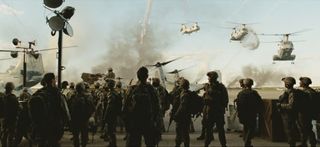
Keeping It Light
Despite the tone of the film’s trailers playing up the darkness of war and the desperation of our troop’s situation, Liebesman is keen to point out that Battle: Los Angeles isn’t really as grim as all that.
“One of the big parts of Chris’ script is humour,” he insists. “And one of the things when you’re doing a film with Neal Moritz is going to be humour.
“And the thing is, we want to make a movie that’s entertaining. That you want to go watch because it’s a popcorn film. But at the same time, you want to give it an extra level underneath that there is a believability and reality to it so that it’s not something disposable that you just go, ‘Oh, fuck…’
“The one director that I think gets it right for our generation is J.J. Abrams with, say, Star Trek .
"I think that’s an excellent balance of entertainment and seriousness to give you something that feels like a real, gripping story. So I think that’s what we’re going for.” Not that there won’t be violence...
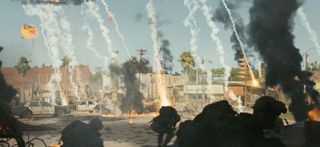
Violent Times
The aliens might all be CG, but Liebesman had no intention of skimping on in-frame destruction. He reveals that he wanted to be “as practical as possible” when it came to his realistic alien invasion film.
“Location wise, shooting everything,” he says. “Explosions, practical. All the special effects elements are shot on blue-screen, but I don’t want CG smoke or that type of stuff.”
That in itself presented its own challenge, but Liebesman had no problem with that. “I feel like it’s what I have loved doing the most,” the director reasons.
“It was a challenge, but at the same time, it was something that I loved. To me, challenges are things you don’t enjoy. I think the things you enjoy aren’t a challenge.
“The takes were long, but they were cut up like United 93 . The takes are ten minutes, but then you cut them up with having two cameras covering. It’s also around sixteen characters, and it’s difficult to cover every character.”
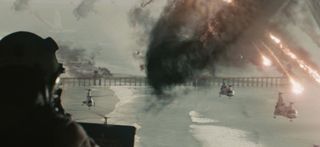
Bad Language
Meanwhile, the director wades into the war on film classification by admitting he had no problem making a PG-13 movie – something that other high-violence films have had trouble getting around.
Says the director: “It’s PG-13, and the reason I didn’t debate was because I feel like you can create so much fear and suspense in a PG-13 situation. I think occasionally gore and stuff like that is unnecessary.
“Look at movies like The Dark Knight , there’s great suspense and psychological fear that comes out of PG-13 films these days, cause the ratings are pretty hard what you get away with.
“You just want something like ‘fuck’ every second word. Which, marines say it a lot, I really feel we can live without it and when I see the scenes and the intensity we have, I don’t miss it.”
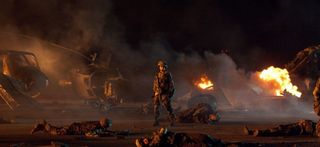
Battle: Elsewhere?
Battle: Los Angeles opens this Friday 11 March. The astute observer will have noted that colon-heavy title, and might well be wondering if there could be other battles in the future.
“I think…[ that ] would be awesome to explore if an audience is interested in more [ movies ],” Liebesman says. “Which I don’t know, we’ll see.”
For his part, Eckhart thinks Hollywood is becoming more dependent on tentpole films – which could mean Battle sequels if Battle: LA is a success.
“I think definitely Hollywood is shrinking,” the actor muses. “The movies they’re making, they’re just making tentpoles movies now and they’re making big remakes, the safe bets. But definitely the budgets aren’t there, the salaries aren’t there. It’s really tightened up big time.
In a time when more and more movies are going 3D, Battle: Los Angeles could give audiences tired of the headache-inducing format a respite. With 3D-free CG movie Rango having just scored the biggest movie opening of 2011, being 3D-free isn’t necessarily a bad thing.
“No, no,” says Liebesman of the decision to shoot Battle: LA traditionally. “It’s too handheld, and you’d throw up in two minutes.”
Josh Winning has worn a lot of hats over the years. Contributing Editor at Total Film, writer for SFX, and senior film writer at the Radio Times. Josh has also penned a novel about mysteries and monsters, is the co-host of a movie podcast, and has a library of pretty phenomenal stories from visiting some of the biggest TV and film sets in the world. He would also like you to know that he "lives for cat videos..." Don't we all, Josh. Don't we all.

